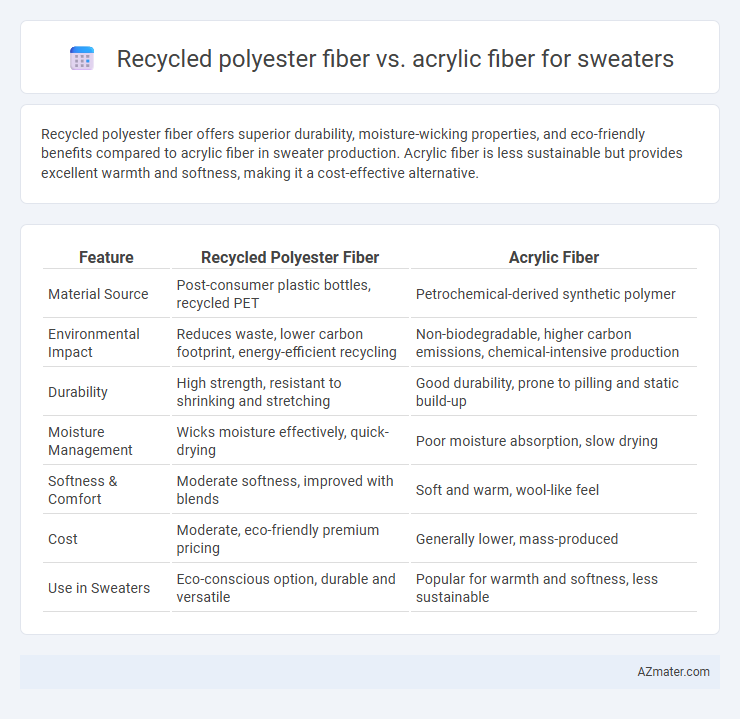Recycled polyester fiber offers superior durability, moisture-wicking properties, and eco-friendly benefits compared to acrylic fiber in sweater production. Acrylic fiber is less sustainable but provides excellent warmth and softness, making it a cost-effective alternative.
Table of Comparison
| Feature | Recycled Polyester Fiber | Acrylic Fiber |
|---|---|---|
| Material Source | Post-consumer plastic bottles, recycled PET | Petrochemical-derived synthetic polymer |
| Environmental Impact | Reduces waste, lower carbon footprint, energy-efficient recycling | Non-biodegradable, higher carbon emissions, chemical-intensive production |
| Durability | High strength, resistant to shrinking and stretching | Good durability, prone to pilling and static build-up |
| Moisture Management | Wicks moisture effectively, quick-drying | Poor moisture absorption, slow drying |
| Softness & Comfort | Moderate softness, improved with blends | Soft and warm, wool-like feel |
| Cost | Moderate, eco-friendly premium pricing | Generally lower, mass-produced |
| Use in Sweaters | Eco-conscious option, durable and versatile | Popular for warmth and softness, less sustainable |
Introduction to Sweater Fiber Choices
Recycled polyester fiber offers a sustainable alternative to traditional synthetic fibers by utilizing post-consumer plastic waste, reducing environmental impact in sweater production. Acrylic fiber is known for its softness, warmth, and lightweight properties, mimicking wool while being easier to care for. When selecting fibers for sweaters, considerations include durability, moisture-wicking ability, thermal insulation, and environmental footprint.
Overview of Recycled Polyester Fiber
Recycled polyester fiber, derived from post-consumer PET bottles and industrial polyester waste, offers a sustainable alternative to virgin polyester with lower environmental impact and energy consumption. This fiber exhibits excellent durability, wrinkle resistance, and moisture-wicking properties, making it ideal for sweaters requiring long-lasting performance and comfort. Compared to acrylic fiber, recycled polyester provides superior strength, faster drying times, and enhanced breathability while contributing to waste reduction and resource conservation.
Understanding Acrylic Fiber Composition
Acrylic fiber is a synthetic polymer composed primarily of polyacrylonitrile, known for its wool-like feel, lightweight properties, and resistance to moisture and UV rays. In comparison to recycled polyester fiber, which is derived from post-consumer plastic waste like PET bottles, acrylic offers superior softness and thermal insulation but lacks the environmental benefits of recycled content. Understanding acrylic's chemical composition highlights its durability and colorfastness, making it a popular choice for sweaters despite its less sustainable production process.
Sustainability: Recycled Polyester vs Acrylic
Recycled polyester fiber significantly reduces environmental impact by repurposing plastic waste and lowering greenhouse gas emissions compared to virgin polyester production, making it a more sustainable choice for sweaters. In contrast, acrylic fiber, derived from fossil fuels, generates higher carbon emissions and is less biodegradable, contributing to persistent microplastic pollution. Choosing recycled polyester fiber enhances circularity in the fashion industry through waste reduction and resource efficiency while acrylic counterparts often rely on non-renewable, environmentally harmful processes.
Softness and Comfort Comparison
Recycled polyester fiber offers enhanced softness and moisture-wicking properties, making sweaters feel more breathable and comfortable against the skin compared to acrylic fiber. Acrylic fiber, while warm and lightweight, tends to be less breathable and can sometimes cause irritation or a rougher texture in sweaters. Consumers seeking sustainable and soft fabric options often prefer recycled polyester for its eco-friendly credentials combined with superior comfort.
Durability and Wear Performance
Recycled polyester fiber outperforms acrylic fiber in durability due to its higher resistance to abrasion, stretching, and pilling, making it ideal for long-lasting sweaters. Polyester's moisture-wicking properties enhance wear performance by keeping the fabric dry and comfortable, whereas acrylic fiber tends to retain moisture and may lead to faster degradation. Both fibers offer warmth, but recycled polyester provides superior resilience and sustainability for extended sweater use.
Warmth and Insulation Properties
Recycled polyester fiber offers superior warmth and insulation compared to acrylic fiber due to its higher thermal retention and moisture-wicking capabilities, making it ideal for sweaters in cold climates. Its dense fiber structure enhances heat retention while allowing breathability, unlike acrylic fiber, which tends to trap moisture and lose insulating properties when wet. Choosing recycled polyester improves sustainability without compromising on comfort or thermal efficiency in winter apparel.
Color Retention and Dyeability
Recycled polyester fiber exhibits superior color retention and dyeability compared to acrylic fiber, maintaining vibrant hues after multiple washes and prolonged exposure to sunlight. The molecular structure of recycled polyester allows for better absorption of disperse dyes, resulting in more consistent and long-lasting colors. Acrylic fiber, while offering good initial brightness, tends to fade faster and shows less uniform dye uptake due to its complex dyeing process.
Environmental Impact and Recycling Potential
Recycled polyester fiber for sweaters significantly reduces environmental impact by lowering greenhouse gas emissions and minimizing plastic waste through closed-loop recycling processes. Acrylic fiber, derived from non-renewable petroleum, contributes to higher carbon footprints and challenges in recycling due to its chemical composition and limited recycling infrastructure. The superior recyclability and eco-friendly production of recycled polyester make it a more sustainable choice compared to acrylic fiber in sweater manufacturing.
Cost and Market Availability
Recycled polyester fiber for sweaters offers a cost-effective alternative to acrylic fiber, often priced lower due to its sustainable production processes and growing industrial scale. Market availability of recycled polyester is rapidly increasing, supported by eco-conscious brands and suppliers focusing on circular economy principles. Acrylic fiber remains widely available but typically comes at a slightly higher cost because of its synthetic origin and production energy requirements.

Infographic: Recycled polyester fiber vs Acrylic fiber for Sweater
 azmater.com
azmater.com